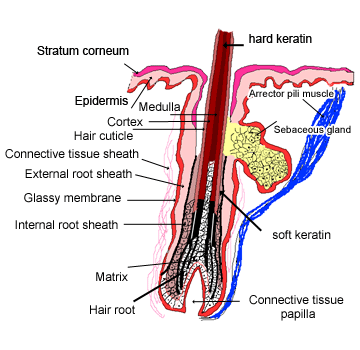Hair

Hair follicles are tubular invaginations of the epidermis, that develop as downgrowths of the epidermis into the dermis. Hair is made up of columns of dead keratinised cells.
The hair has three layers:
A central medulla, or core (not seen in fine hairs), surrounded by a keratinised cortex, and the outer third layer, which is highly keratinised and forms the thin hard cuticle on the outside of the hair. These keratinised layers are made by proliferating cells in the hair matrix at the base of the hair follicle.
Surrounding the hair, towards the base of the hair follicle is the internal root sheath, which consists of keratinised cells from the hair matrix. The type of keratin here is softer than that of the hair, and is the same as that found on the surface of the skin.This layer of cells disintegrates where the ducts of the sebaceous gland enters the hair.
Surrounding the internal root sheath is the external root sheath. This is a tubular invagination of the epidermis which doesn’t take part in hair formation. Finally, it is separated from the surrounding connective tissue by a glassy basement membrane.
At the base of the hair follicle/hair bulb, there is a dermal papilla, which contains the blood supply for the hair. The hair matrix, which contains the proliferating cells that generate the hair and the internal root sheath, is just above the dermal papilla, and separated from it by a basement membrane. Like the basal layer of the epidermis, the cells in the hair matrix proliferate and move upwards, gradually becoming keratinised to produce the hair.
The ducts of the sebaceous glands discharge sebum onto the hair. Find out more.
The arrector pili muscle is a small bundle of smooth muscle cells associated with the hair follicle. Contractions of this muscle elevate the hair, forming goose bumps, to release heat and help sebum to be released from gland into duct.

This is a photo at low magnification of some hairs. See if you can identify the epidermis, Arrector pili muscle, sebaceous gland, internal and external root sheaths, hair matrix, and hair bulb, connective tissue sheath, glassy basement membrane and the hard keratin of the hair.
Hair colour, like skin colour, depends on the pigment melanin. However, in hair, there are alternative forms:
pheomelanin (red or yellow) and eumelanins (brown or black). Melanocytes are found in the hair matrix, and the pigment is passed onto the cells in the matrix in the same wayas it is passed to keratinocytes in the epidermis. As the progeny of melanin-containing matrix cells change into hard keratin, they keep their pigment.
Eventually, in old age, the melanocytes stop producing melanin, and hair turns white.
Hair follicles alternate between growing and resting phases. They only produce hair in the growing phase. In the resting phase, the hair falls out, and eventually a new hair will start to grow. In the scalp, the growing phase lasts several years. However, sometimes hairs are permaently lost, resulting in baldness. There is a genetic predisposition for this (male pattern alopecia), and it requires the presence of androgen.
Cutting hair does not change the growth rate.




